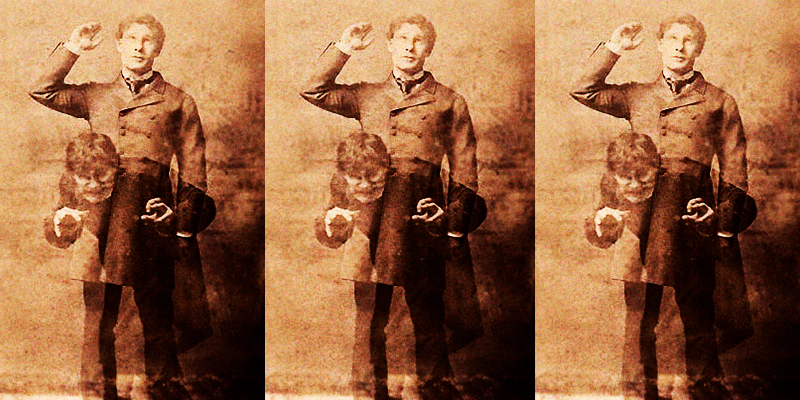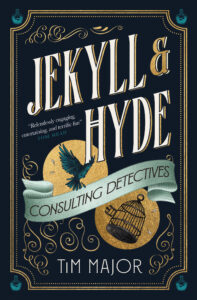Robert Louis Stevenson’s 1886 novella Strange Case of Dr Jekyll and Mr Hyde is itself a strange case. The fact that its initial success as a ‘shilling shocker’ was due to its thrilling conclusion is difficult to appreciate nowadays, given that the ‘punchline’ is known to all. The central revelation—Jekyll and Hyde are one and the same person—is unlikely to elicit a gasp of shock from anyone, and its fame is almost unrelated to the actual plot as it plays out in the novella.
The main aspect of Stevenson’s novella that became lodged in the public consciousness is the concept of the duality of man being made literal: the phrase ‘a Jekyll and Hyde personality’ is commonly used to describe somebody with dramatic changes in mood or behaviour. Also timeless are Stevenson’s characters, which are archetypes: the upstanding Dr Jekyll and the ‘ape-like’ and violent Mr Hyde, whom Jekyll refers to as ‘the expression… of lower elements in my soul’. Yet, like many of the best-known fictional characters, they’ve become divorced from their origins. While almost everyone in the western world knows of Jekyll and Hyde, far fewer have direct experience of the original Strange Case of Dr Jekyll and Mr Hyde, and reading it would almost certainly surprise most people.
That’s because the novella is structured as a mystery, with the revelation about Jekyll and Hyde’s true relationship divulged only in the ninth chapter of ten. Initially, the puzzle relates to the activities of a violent, strange man, Edward Hyde, who has been witnessed trampling a child in the street and then bribing the child’s family with a cheque for £100 in exchange for their silence. The fact that the cheque was signed by Dr Henry Jekyll implicates the doctor in Hyde’s activities.
Furthermore, it’s a mystery with an amateur detective at its heart, albeit a detective with a personal stake in the outcome. When lawyer Gabriel Utterson hears of Hyde’s act and the link to Henry Jekyll, he becomes involved instantly because Jekyll is his friend and client. When questioned, Jekyll is coy about his relationship to Hyde, despite the fact that he’s instructed Utterson to amend his will to make Hyde the sole beneficiary. A year later, the stakes are raised when Hyde kills an elderly MP, Sir Danvers Carew, in the street at night.
Most of the novella relates to Utterson’s search for information about Edward Hyde, and the nature of his close relationship with Jekyll. While Stevenson’s initial drafts of the novella referred directly to the possibility that Hyde may be Jekyll’s son, his decision to downplay this connection results in more emphasis being placed on less straightforward relationships. Initial readers of the novella would have thrilled at the hints of homosexuality – Hyde is referred to as ‘Henry’s Jekyll’s favourite’, and Utterson notes ‘It turns me cold to think of this creature stealing like a thief to Harry’s bedside’. Jekyll himself is implicated in shady goings-on, too, with references to him having been ‘wild when he was young’ and having become ‘the slave of disgraceful pleasures’.
Like Dracula, Stevenson’s novella feels surprisingly modern due to its reliance on witness testimonies rather than omniscient narration, and the use of newspaper articles widens the scope by emphasising the response of Victorian society to Hyde’s crimes. As information is gathered, we learn about Jekyll’s and Hyde’s backstory in piecemeal, non-chronological fashion. The final two chapters are comprised of characters’ own accounts: first Dr Lanyon, who finally reveals to the reader that Jekyll is capable of transforming into Hyde; then Henry Jekyll himself, in what is effectively a long suicide note.
At first, the critical and public response to the novella centred on its moral lesson about duality and repressed violence. What made the story into a sensation was its adaptation as a stage play starring and co-written by Richard Mansfield. With Stevenson’s blessing, the plot changed from a detective-mystery narrative to a melodrama. Audiences already knew that Jekyll would turn into Hyde, so they required other stakes – hence the introduction of Henry Jekyll’s fiancée, who complicates the situation not only because she represents a tangible reason for Jekyll to guard his secret, but also because she’s the daughter of the murdered Danvers Carew.
There have been countless stage and film versions of the Jekyll and Hyde tale, but they’re almost all adaptations of the Mansfield stage play, or at least derivations of it, in the sense that the transformation aspect is placed front and centre rather than being withheld from the audience.
For understandable reasons, the central sense of mystery related to Jekyll and Hyde has been abandoned.
Is it churlish of me to want to reinstate it?
It’s impossible to turn back the clock, of course. I can’t simply will readers to forget that Jekyll and Hyde are the same person. In revisiting the characters in my own work, I decided that the primary mysteries would relate to external events, and I would reintroduce the mystery aspect by making both Jekyll and Hyde the solvers of the puzzles. The result is Jekyll & Hyde: Consulting Detectives.
I loved the idea of a detective duo each with specific skills: Henry Jekyll’s cold, Holmesian intellect; Edward Hyde’s charisma and brute strength. Yet they can’t communicate with each other, and they might change from one to the other at the most inopportune moments. I’m a fan of the flawed-detective trope, and here we have two in one! (It’s always been my opinion that Henry Jekyll is a hypocrite who may believe he’s isolated his ‘lower elements’, but who remains as dysfunctional as ever, and of course he’s also severely compromised by his relationship to Edward Hyde.)
And I could have my cake and eat it. While readers would be fully aware of the nature of Jekyll and Hyde’s relationship, other characters in the novel wouldn’t, particularly as a decade has passed since Hyde last terrorised London. Enter Muriel Carew, Henry Jekyll’s former fiancée – an inclusion that establishes my novel as merging aspects of the original novella and its many adaptations, which neatly allows me to sidestep a handful of canonical issues! Jekyll & Hyde: Consulting Detectives is primarily Muriel’s narrative, and she’s as eager to learn about her former fiancé and his partner as she is about the spate of crimes that they’re investigating – not least because she suspects Hyde of killing her father.
As for the investigation itself… well, I won’t say too much about it. While the Jekyll–Hyde transformation is a known quantity, I’m keen that the other mystery should be discovered by readers for themselves. All I’ll say is that I thoroughly enjoyed inventing a series of crimes that relate to the themes of Robert Louis Stevenson’s 1886 novella: Gothic doubles, Victorian hypocrisy, the duality and the secret crimes of men.
I do hope you’ll be shocked.
***


















